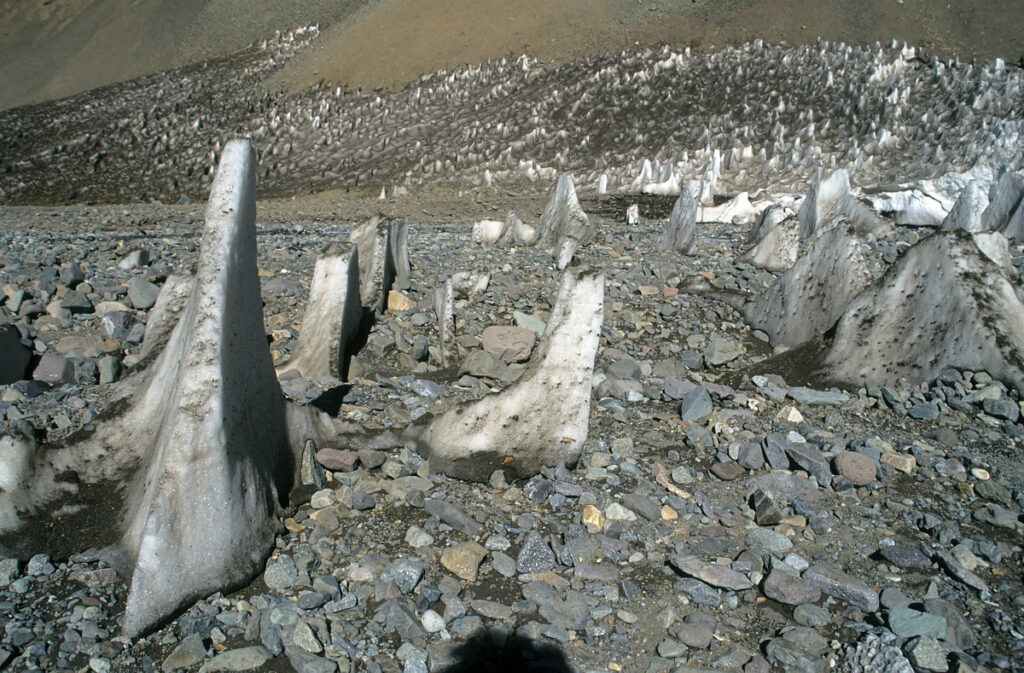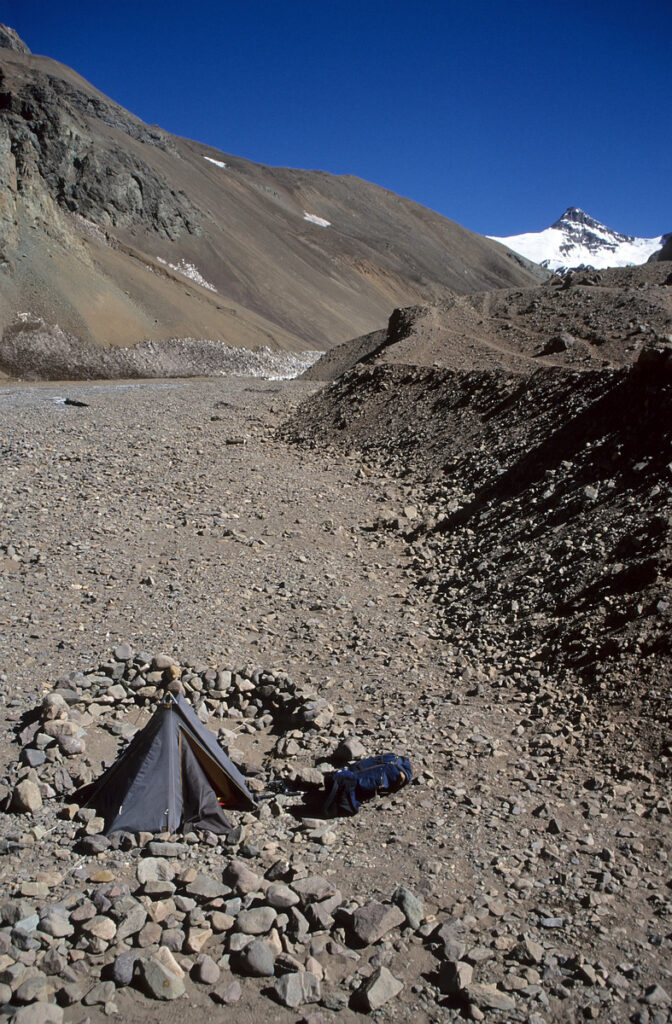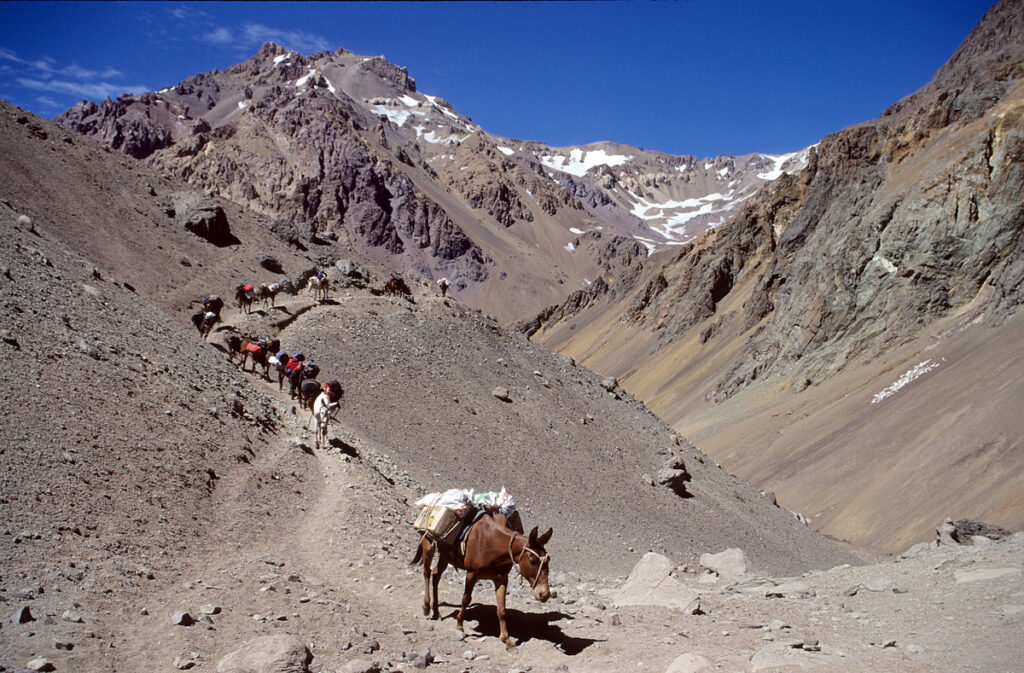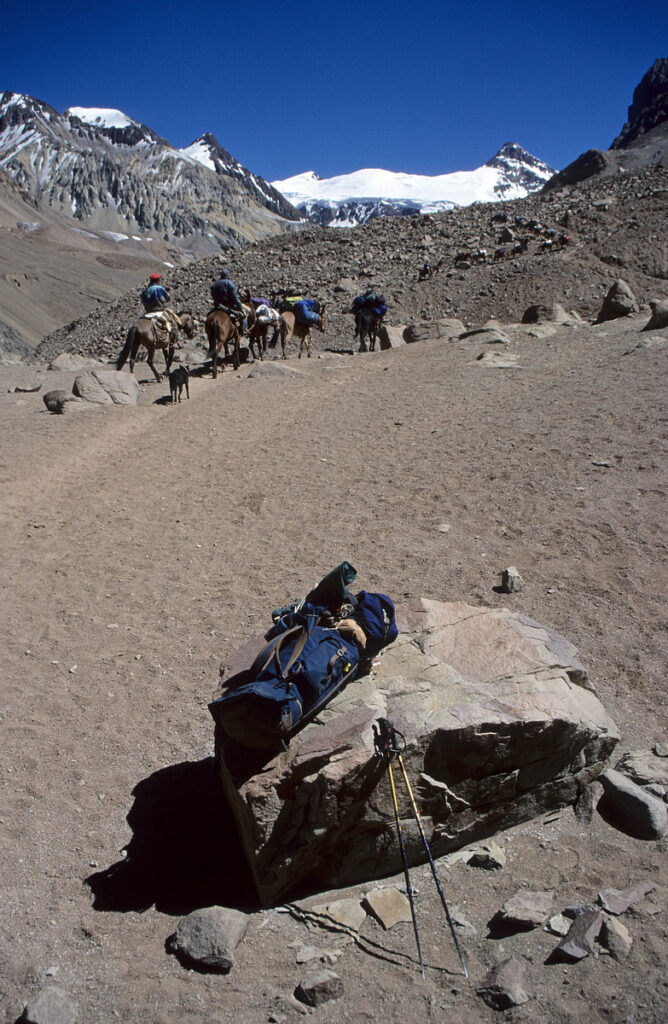Sunday 11th January dawned another calm and sunny day, but I couldn’t persuade myself to get out of bed before 9:15 am, which was the time the sun hit the bottom of the valley (having initially been blocked by Aconcagua) and the temperature in the tent rose by 20 C. In fact this “9:15 instant warm-up” was to become a feature of all the campsites, including the top camps. The phenomenon resulted in there being just one day in the whole trip that I managed to drag myself out of my sleeping bag before 9:15.
Whilst I was heating some water for coffee and porridge, Tim and Tork passed by on their way up to Plaza de Mulas. Before taking the tent down I wandered up to the penitentes again to take some photos with the sun on them. The surface of the snow was rough because of all the wind blown debris, and I was able to climb up amongst the penitentes in my trainers without any problem.
An hour later I heaved everything on to my back and headed up the path once more. The valley steepened considerably, and the going was more difficult. The advantage of using the sticks for stability became even more apparent. The path went up and down repeatedly as it crossed over spurs that came down from Aconcagua, which was now towering above me on the right. There were boulders all over the place, that had rolled down from above. After a while I found a convenient sized one for a snack-stop (I had discovered that the effort of taking off and putting on my rucksack was reduced drastically if I first found a flattish boulder roughly 80 centimetres high on which to set the rucksack down). The rocky valley was now totally barren : I had seen my last vegetation for two weeks.
Some mules came up behind, eventually followed by their human boss : the “muleteer”. Most of the mules seemed to be left to find their own way along the path, the muleteer riding along at the back chivvying any stragglers, and towing any really unruly ones with a length of rope. Sometimes the most enthusiastic mules at the front would be a couple of hundred metres in front of the muleteer. Judging from the number of rucksacks being carried by mule there seemed to be a vast number of lazy mountaineers around.
The truth was that carrying everything myself had turned out to be far from unbearable, and was giving me a lot of extra satisfaction. Then again of course, if no mules had been available, or if nobody else used them, then carrying everything wouldn’t have given me any extra satisfaction whatsoever : the satisfaction just came from a feeling of superiority! This in turn must just be further evidence of what many people claim, that mountaineering can be just as competitive as any other sport. When I returned from Aconcagua, few people asked me if I had a good time – most started with the same question : “How high did you get?”.
Furthermore, throughout the trip I noticed that anyone who was returning from a successful summit bid was treated with a kind of reverent awe. People who themselves reasonably expected to reach the summit within a few days would almost appear to feel unworthy in the presence of someone who had made it, and was on their way down : ”If you would permit me to grovel in your presence, oh great all-powerful Returning Summiteer, in order to ask you how long it takes from Berlin camp to the bottom of the Canaleta?” . Not quite that bad perhaps, but the fact that the majority of people who attempt Aconcagua fail to reach the summit does cause the status of those who have made it to be elevated to that of local celebrities.
I carried on slowly up Los Horcones valley and was caught up by a group who were just carrying day sacks and didn’t seem to speak English or Spanish. The path crossed several areas of penitentes, one of which I had to cross with a couple of impatient mules right behind me. Eventually the valley widened again, and I saw a few km up ahead on the right what I assumed were the slopes that would lead up to Plaza de Mulas.
I seemed to be making good time, so I stopped for another rest. Several more East Asians – I figured they were also Japanese – passed me, heading down. They all looked a little downcast, and I wondered whether they had reached the summit or not. Anecdotally, I had the impression that Japanese climbers are a very proud breed, and notably reluctant to give up. I figured that failing to reach the summit would be hard, especially if there is a large group of them and most of them do make it. Seeing rather serious-looking Japanese descending, was in contrast to a celebrated quote from sharp-witted Lancastrian mountaineer Don Whillans, regarding Japanese mountaineers. Climber and author Tom Patey describes being forced by a storm to retreat on the infamous North Wall of the Eiger, when suddenly a gung-ho Japanese team appear, and pass them, still going up. “Japanese climbers always go upwards, ever upwards!”, the Japanese team announce proudly. “Aye..”, mutters Don Whillans sarcastically, convinced that the Japanese will shortly be meeting their maker, “..aye, you’re going up, but a lot higher than you think, mate”.
I was sitting contemplating the problems that a Japanese of the “upwards ever upwards” variety might have in turning back on Aconcagua, when a shout from a muleteer up ahead suddenly brought me back to the present. The muleteer was descending the valley slowly, with another mule in tow – the expression on the muleteer’s face was a mixture of pride and self importance. The path was narrow, and he seemed to be alerting me that the bundle on the second mule was going to hit me if I didn’t move slightly, as it was a long curved bundle spread sideways over the back of the mule. I shifted, and as the mules passed I saw there was what looked like Japanese writing on the bundle, which was about six feet long. Then at one end I saw the soles of a pair of plastic boots sticking out, and I realised, with an intense shock, what I was looking at. The muleteer looked back over his shoulder and saw my expression : “Japanese”, he explained, unable to disguise his glee, “..he froze.” I digested this cheery news, suddenly feeling ill. Finally, in the direction of the disappearing body bag, I muttered: “Aye…and you’re going a lot higher than you think, mate”.







Frozen, they say that’s a pleasant way to go as you just fall asleep. On treks in the Himalayas I saw porters carrying the walking wounded off the mountains in wicker baskets on their backs. Human as opposed to mule power.